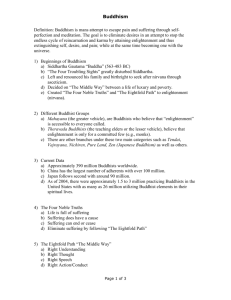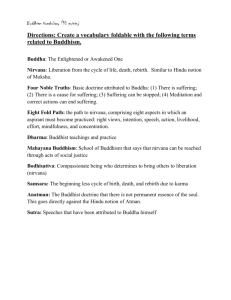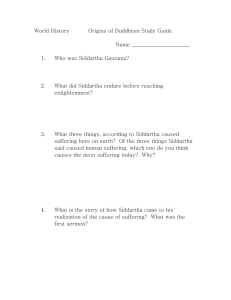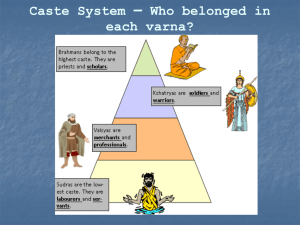Key Terms and People Taking Notes
advertisement
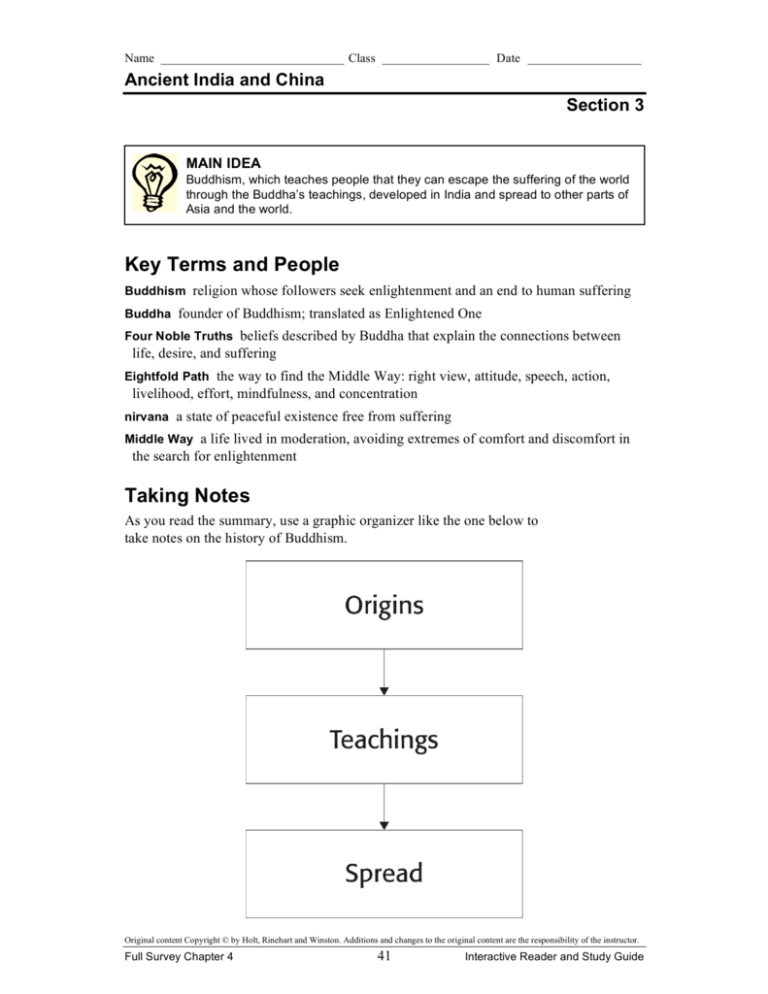
Name _____________________________ Class _________________ Date __________________ Ancient India and China Section 3 MAIN IDEA Buddhism, which teaches people that they can escape the suffering of the world through the Buddha’s teachings, developed in India and spread to other parts of Asia and the world. Key Terms and People Buddhism religion whose followers seek enlightenment and an end to human suffering Buddha founder of Buddhism; translated as Enlightened One Four Noble Truths beliefs described by Buddha that explain the connections between life, desire, and suffering Eightfold Path the way to find the Middle Way: right view, attitude, speech, action, livelihood, effort, mindfulness, and concentration nirvana a state of peaceful existence free from suffering Middle Way a life lived in moderation, avoiding extremes of comfort and discomfort in the search for enlightenment Taking Notes As you read the summary, use a graphic organizer like the one below to take notes on the history of Buddhism. Original content Copyright © by Holt, Rinehart and Winston. Additions and changes to the original content are the responsibility of the instructor. Full Survey Chapter 4 41 Interactive Reader and Study Guide Name _____________________________ Class _________________ Date __________________ Ancient India and China Section 3 Section Summary THE LIFE OF BUDDHA Buddhism, another of the world’s major religions, originated in ancient India. It was founded by a single person, called the Buddha. Buddhist writings tell of a prince named Siddhartha Gautama who was born in the 500s BC. His life was so sheltered that he did not know suffering existed until he was almost 30. When he did learn of sickness and death, he left his palace to try to find a way to end human suffering. For six years, Gautama sought enlightenment, or spiritual understanding. He lived alone in the forest, then with gurus who taught him meditation, and finally with monks who denied themselves basic necessities. Gautama decided that neither the gurus nor the monks could teach him the way to enlightenment. He decided to sit under a tree until he found the way to end human suffering. After meditating for a long time, he was transformed: he had found enlightenment. He then became known as the Buddha, which means “Enlightened One.” THE TEACHINGS OF BUDDHISM After he achieved enlightenment, the Buddha set out to spread what he had learned to other people. His lessons became the basic teachings of Buddhism. Buddha is said to have learned the Four Noble Truths while meditating. The Four Noble Truths are: suffering is a part of human life, suffering comes from desires for pleasure and material goods, overcoming desire brings suffering to an end, and desires can be overcome by following the Eightfold Path. The Eightfold Path includes right view, right attitude, right speech, right action, right livelihood, right effort, right mindfulness, and right concentration. The Buddha taught that those who followed the Eightfold Path could attain nirvana. Nirvana is a state of peaceful existence free from suffering. Those who do not reach nirvana will be reborn to live through the cycle of suffering again. The Eightfold Path is also called the Middle Way. It calls for living in moderation, and avoiding extremes of comfort or discomfort in the search for enlightenment. Where and when did Buddhism start? _______________________ _______________________ Why did Buddha believe that living according to the Eightfold Path was important? _______________________ _______________________ Original content Copyright © by Holt, Rinehart and Winston. Additions and changes to the original content are the responsibility of the instructor. Full Survey Chapter 4 42 Interactive Reader and Study Guide Name _____________________________ Class _________________ Date __________________ Ancient India and China Section 3 After the Buddha died, three main Buddhist traditions formed—Theravada, Mahayana, and Tibetan Buddhism. Theravada is based on the oldest known Buddhist writings. Theravada teaches that the best way to attain nirvana is to become a monk or a nun and spend all of one’s time in meditation. Mahayana teaches that people can help each other find enlightenment. Bodhisattvas, people who have found enlightenment but have not yet passed on to nirvana, are said to remain on Earth to help others find their way to nirvana. The third Buddhist tradition, Tibetan Buddhism, shares many teachings with Mahayana. However, Tibetan Buddhists also believe that they can use special techniques to harness spiritual energy and achieve nirvana in a single lifetime. THE SPREAD OF BUDDHISM Unlike Hinduism, which largely remained an Indian religion, Buddhism spread to other parts of the world. Today, more than 350 million people are Buddhists, most of them in Asia. Relatively few people in India are Buddhists today. After his death, the Buddha’s followers spread his teachings. These teachings were not written down until the first century BC. Buddhism reached its peak in India in the 200s BC during the reign of the emperor Ashoka. Ashoka helped spread Buddhism into all parts of India. He encouraged missionaries to carry the Buddha’s message to lands outside of India. Trade also helped to spread Buddhism beyond India into Central Asia and China. In China, Buddhism slowly spread and blended with native Chinese philosophies. From there, Buddhism went to Korea and Japan, making it the leading religion in all of East and Southeast Asia. As Buddhism encountered other religious traditions outside of India it continued to change and develop. Because of this blending, various smaller traditions developed within Theravada and Mahayana. For example, a branch of Mahayana known as Zen emphasizes self-discipline and meditation. Buddhism today is a very diverse religion with a wide range of adherents and practices. Underline the names of the three main Buddhist traditions. By what two means did Buddhism spread throughout India and into the East and Southeast Asia? _______________________ Original content Copyright © by Holt, Rinehart and Winston. Additions and changes to the original content are the responsibility of the instructor. Full Survey Chapter 4 43 Interactive Reader and Study Guide



